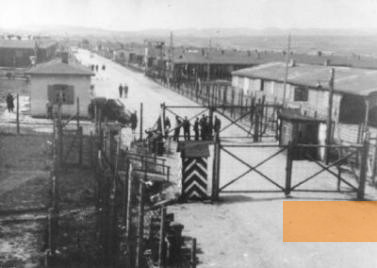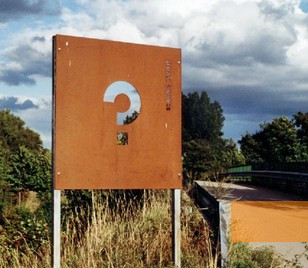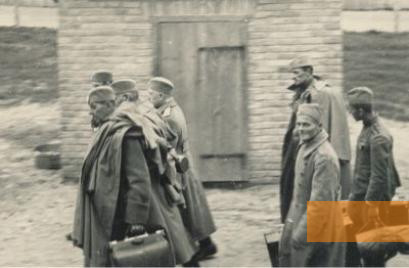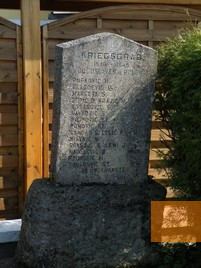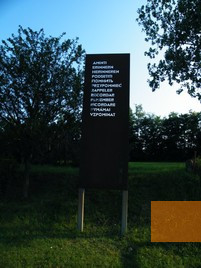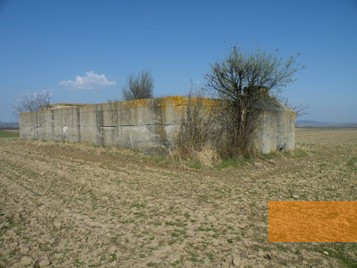In 2000, several memorial plaques and memorial stones were set up in the Gneixendorf district of the Lower Austrian town of Krems an der Donau in honour of the inmates of »Stalag XVII B«, a prisoner of war camp.
In 1939, the Wehrmacht set up the prisoner of war camp »Stalag« XVII B in Gneixendorf close to Krems an der Donau. It was one of the largest prisoner of war camps within the borders of the German Reich.
During the war, there were up to 66,000 prisoners of war held captive in the camp at a time. The inmates were mainly from France, Belgium, Serbia, Poland, Great Britain, the Soviet Union as well as from Italy. Moreover, there were 4,000 members of the US Air Force in the camp. Most of them had to perform forced labour in one of the numerous labour detachments, which worked in local agriculture and forestry, mining, industry and trade or in construction. The mortality rate was highest among Soviet prisoners of war, who were subjected to particularly harsh conditions. About 1,640 were buried in the camp cemetery »Forest cemetery at Krems-Gneixendorf«. Several prisoners of war of other nationalities were also laid to rest here.
When the Red Army was approaching in April 1945, the guards chased all of the remaining prisoners who were able to walk on a march to the collection camp at Weilhartsforst near Braunau, about 300 kilometres away. On May 3, 1945, US troops liberated Weilhartsforst. The prisoners who had remained at Stalag XVII B because they were not able to march were liberated by the Red Army on May 9, 1945.
During the war, there were up to 66,000 prisoners of war held captive in the camp at a time. The inmates were mainly from France, Belgium, Serbia, Poland, Great Britain, the Soviet Union as well as from Italy. Moreover, there were 4,000 members of the US Air Force in the camp. Most of them had to perform forced labour in one of the numerous labour detachments, which worked in local agriculture and forestry, mining, industry and trade or in construction. The mortality rate was highest among Soviet prisoners of war, who were subjected to particularly harsh conditions. About 1,640 were buried in the camp cemetery »Forest cemetery at Krems-Gneixendorf«. Several prisoners of war of other nationalities were also laid to rest here.
When the Red Army was approaching in April 1945, the guards chased all of the remaining prisoners who were able to walk on a march to the collection camp at Weilhartsforst near Braunau, about 300 kilometres away. On May 3, 1945, US troops liberated Weilhartsforst. The prisoners who had remained at Stalag XVII B because they were not able to march were liberated by the Red Army on May 9, 1945.
About 1,640 Soviet prisoners of war and many of other nationalities died of the effects of forced labour and the harsh conditions in the camp.
Already in 1945, Soviet military personnel discovered the bodies of about 1,640 soldiers of the Red Army who had been buried in the camp cemetery.
After 1945, Soviet troops used the former camp barracks as temporary housing. Later, the buildings of the camp were torn down and the premises levelled out. Today, only a few remains of the camp are still visible.
In 2000, Christian Gmeiner, an artist from Krems, set up plaques at four prominent spots on the former camp premises marked »Stalag XVII B ?«. The plaques and several memorial stones along Flughafenstraße commemorate the prisoner of war camp and the fate of its inmates.
After 1945, Soviet troops used the former camp barracks as temporary housing. Later, the buildings of the camp were torn down and the premises levelled out. Today, only a few remains of the camp are still visible.
In 2000, Christian Gmeiner, an artist from Krems, set up plaques at four prominent spots on the former camp premises marked »Stalag XVII B ?«. The plaques and several memorial stones along Flughafenstraße commemorate the prisoner of war camp and the fate of its inmates.
- Name
- Stalag XVII B Krems-Gneixendorf
- Address
-
Flughafenstraße Gneixendorf
3500 Krems an der Donau - Phone
- +43 (0)273 275 077
- Fax
- +43 (0)273 275 077
- Web
- http://www.erinnern.at/bundeslaender/oesterreich/gedaechtnisorte-gedenkstaetten/katalog/stalag_xvii_b
- cgmeiner@aon.at
- Open
- The memorial plaques are accessible at all times.
- Possibilities
- Guided tours for school groups and adults


